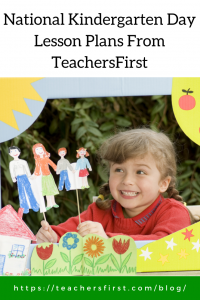Kindergarten children are confident in spirit, infinite in resources, and eager to learn. Everything is still possible.
Robert Fulgham
German educator Friedrich Fröbel, the founder of the first play and activity institute, was born on April 21, 1782. His institute, which opened in 1837, became known as ‘kindergarten’ or children’s garden. In the United States, the first public school kindergarten opened in St. Louis in the 1870s. The last state to open public school kindergarten classes was Mississippi in 1982.
 Maria Montessori is another pioneer of early childhood education. Her philosophy of learning through exploration and play is well-known and continues in practice around the world. Her theories of teaching and learning inspired other leaders, including Anna Freud, Jean Piaget, Alfred Adler, and Erik Erikson.
Maria Montessori is another pioneer of early childhood education. Her philosophy of learning through exploration and play is well-known and continues in practice around the world. Her theories of teaching and learning inspired other leaders, including Anna Freud, Jean Piaget, Alfred Adler, and Erik Erikson.
Last year Dr. Ruth Okoye discussed the use of digital tools with kindergarten students in her blog. She shared a rubric for evaluating digital tools and provided information choosing the appropriate instructional strategies for the most effective use of technology. The tools and techniques support educators in trying to incorporate technology in appropriate ways for their young learners.
TeachersFirst offers many free resources for kindergarten; in fact, the number of resources is overwhelming! A search for K-1 math produces over 500 results, K-1 reading over 600 results, and science results of almost 600 resources. Instead of searching based on a subject, try to narrow down your search to specific terms such as counting, phonics, or animals for the best results.
One area of TeachersFirst you might miss when using a keyword search is the TeachersFirst lesson plans found under the Classroom Resources tab. These lessons cover all grade levels and topics. Several of the lessons provide hands-on learning experiences for kindergarten students.
- Egg Hatching into Sequencing – using ideas from this lesson plan, students build an egg, hide a snake in the egg, then watch it hatch. The comprehensive lesson includes rubrics, options for using technology, and links to information about snakes.
- Dinosaur Math – teach simple equations and estimation with the materials found in this lesson plan. Use the ideas found in this lesson plan to differentiate learning for your students. For more advanced students, include two-digit addition or apply the same techniques to practice subtraction facts.
- Three Billy Goats Gruff – use this lesson plan to teach reading and retelling strategies, including a final student book-making project. Use the PowerPoint template for the student stories or have students use Story Maker (TeachersFirst review) or WriteReader (TeachersFirst review) to create digital book projects.
- I’ve Got the Blues – this lesson indicates it is 1st to 3rd grade; however, it is easily adaptable for kindergarten, especially late in the school year. The hands-on activities are adapted to the trade book, Blueberries for Sal, and focus on retelling, main idea, and estimation skills.
Many of the resources and activities found on TeachersFirst are adaptable across grade levels. As you use the keyword search on the site, consider adjusting the grade level up to first or second grade to find ideas to modify to suit your needs. Use the frameworks and guidelines shared on Dr. Okoye’s blog to help evaluate and prepare engaging and appropriate learning experiences for your students.
Kindergarten teachers, we salute you and your continued efforts to provide crucial learning opportunities to our young students. Have you tried some of these lessons or others found on TeachersFirst? Do you have a favorite kindergarten resource to share? Let us know in the comments below as we all celebrate National Kindergarten Day.

